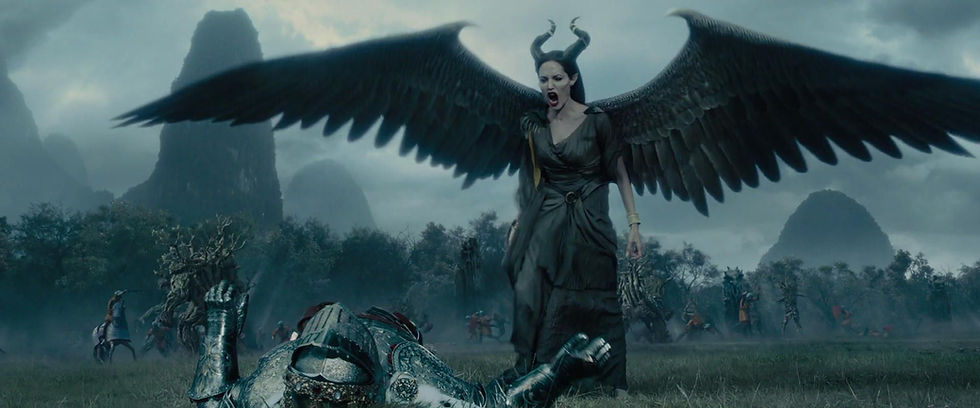Maleficent
- Vivian Rodriguez
- Oct 31, 2020
- 4 min read
Updated: Jan 13, 2021
How do you manage to make one of the most evil and feared fairytale villains the protagonist and hero of a film without changing her character? Somehow, Disney does it. Maleficent is an incredibly made film that makes the audience root for the mistress of evil, all while maintaining her villainous qualities that we’ve all so enjoyed.
The story begins with a classic fairytale narration that gives context to this world. The dynamics between the human and fairy kingdom as well as the relationship between Maleficent and Stefan is established. Creating this relationship makes Stefan’s betrayal all the more heartbreaking, thus giving us insight as to why Maleficent is the way that she is.


Stefan drugs Maleficent and then cuts off her wings in what was supposed to be an intimate moment of trust. She falls asleep next to someone she trusts and wakes up alone, in pain, an important part of her body gone- one that gave her freedom and power. This scene is very important and one that I believe symbolizes rape and abuse- and it makes it very clear that the perpetrators can often be those whom the victim loves and trusts. Furthermore, the victim is usually villainized while the perpetrator continues to gain success. It’s a horribly sad moment that makes Maleficent bitter, angry, and set on revenge. It also makes the audience understand her choices better and see Stefan as the antagonist.


When Maleficent makes her grand entrance to Aurora’s christening, her opening monologue is word for word from the animated version, Sleeping Beauty. In Sleeping Beauty, this scene is where we first see Maleficent. By making it occur later in Maleficent, the filmmakers are telling us “now you’re all caught up.” The scene now has a whole new meaning and her words hold more weight to them. Maleficent loved Stefan, and he betrayed and mutilated her for power. While she lives angry and miserable, he grows in success and riches. This baby girl is a symbol of his happiness that he gained by committing evil. Aurora’s birth is the last straw for Maleficent, and so it is her that she pours out her revenge on. She literally curses Stefan’s happiness.


As Maleficent continues to watch over Aurora, she clearly starts to gain affection for her- even though she refuses to admit it. As they form a relationship, Aurora becomes a symbol for Maleficent’s chance of happiness and love.


A great thing about this film is that, while making Maleficent the protagonist whom you root for and feel compassion towards, it does not condone her bad choices. While we understand why Maleficent curses Aurora, it is obvious that she is punishing her for her father’s actions. Once Maleficent comes to realize this, she herself regrets that decision and even expresses her regret to a sleeping Aurora after she’s pricked her finger.

Another wrong choice Maleficent makes is when she establishes herself as ruler over the Moors. It is made clear in the beginning of the film that this kingdom needed no ruler because they trusted each other; however, in her anger over learning that Stefan betrayed her for the crown, Maleficent crowns herself. She makes the kingdom dark and covered in thorns to reflect her heart. This is fixed in the end, as she returns the kingdom to how it once was after her heart is made happy with love and gives the crown to Aurora to unite the kingdoms.


Angelina Jolie’s portrayal of Maleficent is absolutely perfect. Her character undergoes a dramatic transformation that remains believable because of the character consistency. She is written to be a protector of her kingdom and, even while wrongly taking the throne, remains a protector. It's a quality that stays with her, even seen in her protectiveness over Aurora.
Maleficent is also portrayed just as ruthless in her battle against the king’s army as she is to Stefan after he betrays her. While she relies on her wings in the battle, she uses her words and her magic against Stefan.

Stefan establishes himself as a villain and rival against Maleficent. Despite gaining everything he longed for, he continues to grow bitter and out for revenge against Maleficent, just as she does. However, the difference is that Aurora's presence softens Maleficent's heart while her lack of presence in her father's life continues to harden his. The difference between Stefan's and Maleficent's hearts are made clear when Aurora enters the castle and sees her father for the first time in 16 years. Stefan's expression shows no love and he only reacts in anger, as her presence ruins his chance at revenge. Aurora's safety is not about his love for his daughter, but rather his desire to beat Maleficent. Moments later, it is Maleficent's kiss that wakes Aurora, because of her true parental love for her that Stefan lacked.


Making Diaval a human (at times) character was a great addition to the film. Maleficent saves him immediately after she gets her wings cut off. Even though part of it is for her own reasons, it’s also a nice moment of empathy in which she watches another winged creature unable to fly. Diaval becomes her servant; however, unlike most henchmen who’s only purpose is to serve, he maintains a personality and holds the ability to verbally spar with her. He’s a loyal friend who is able to call her out on the feelings she suppresses.

The cinematography, the visual effects, the production design- just the overall look of the film immerses the audience into this fairytale world. As a film about Maleficent should be, the colors remain colder, with an emphasis on blacks, blues, and greens.

This makes Aurora stand out even more, with her warm colored dresses and bright blonde hair. As she is the light in Maleficent’s life, she is the light in the film.

Overall, I was extremely impressed with the execution of this film and all the wonderful components that combined to make it so amazing to watch.



Comments